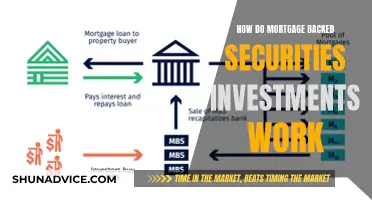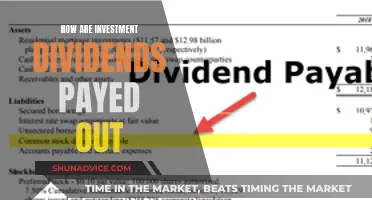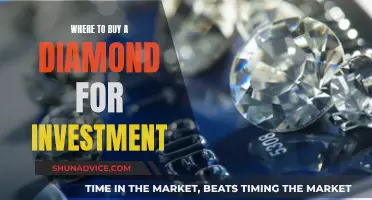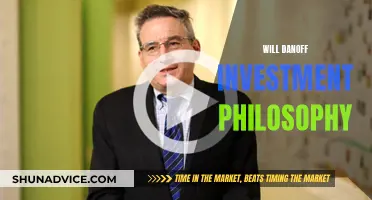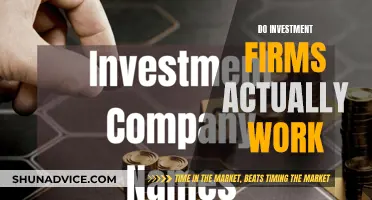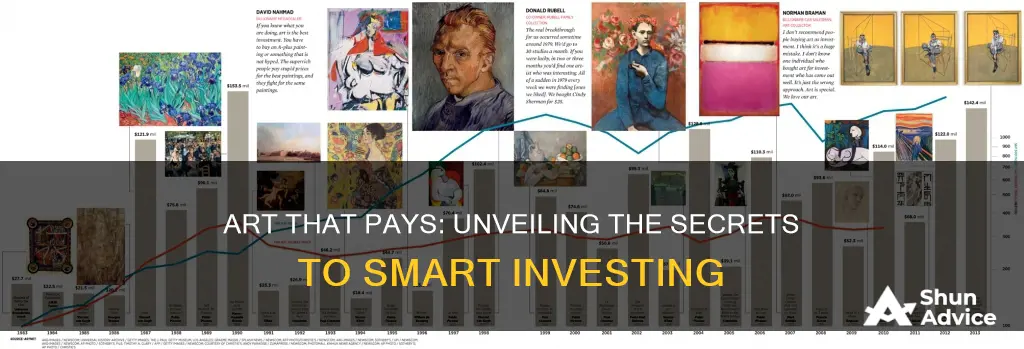
Investing in art is a great way to combine your love of the arts with a hedge against inflation. Art is a massive market with a range of styles and tastes. According to the 2022 Global Art Market Report, the global art market reached $65.1 billion in aggregate sales in 2021, up 29% from 2020. As a tangible asset, art can be a good hedge against inflation and its value is not tied to the performance of the stock market.
Art investment has become increasingly accessible with the rise of online platforms and the demand for non-fungible tokens (NFTs). There are several ways to invest in art, each with its own advantages and disadvantages. These include direct purchases at auctions or galleries, fractional ownership platforms, and investing in publicly traded companies associated with the art world.
When investing in art, it's important to do your research and understand your financial objectives, risk tolerance, and time horizon. Art is a long-term investment and while it can be stable or show large returns during boom times, it can also plummet in value during recessions.
| Characteristics | Values |
|---|---|
| Diversification | Art can be a good addition to a portfolio of stocks and bonds, as its returns are less correlated with traditional assets. |
| Hedge against inflation | As a tangible asset, art can be a good hedge against inflation. |
| Low correlation with stocks | Art is a unique asset class with a low correlation to stocks, bonds and other traditional investments. |
| Long-term investment | Art is a long-term investment and can easily plummet in value during a recession. |
| Emotional rewards | Art can offer both financial and emotional rewards to a collector. |
| Wealth holder | Art can appreciate over a long period if properly cared for. |
| Legacy | Art can be passed down through generations. |
| Alternative asset | Art falls outside traditional asset classes such as stocks, bonds and cash. |
| Accessibility | Art is more accessible than ever, with options available to suit a range of budgets. |
| Risk | Investing in art carries risks, and it is important to consider your budget, intentions, art tastes, and risk tolerance. |
| Expert advice | Seeking expert advice is recommended, as the art market requires a certain level of expertise. |
| Tax implications | Most investments will come with tax implications. |
| Transparency | The art market has seen greater transparency in recent years, thanks to the shift to online marketplaces. |
| Volatility | The art market can be stable or show large returns on investment during boom times. |
What You'll Learn

Art as a hedge against inflation
Art has long been regarded as an investment of passion, and it can also provide potential economic benefits. Art can be a hedge against inflation, and its value can exceed inflation over time. Here are some reasons why art can be a good investment strategy and how to go about it.
Diversification and Stability
Diversifying your investment portfolio is crucial for generating long-term revenue. Art collection has emerged as a solid diversification strategy in recent years. Art is a tangible asset that is not tied to the performance of the stock market. Therefore, it can provide diversification and stability during volatile economic periods. While the stock market can be volatile, art tends to hold its value and is less susceptible to market fluctuations. This makes art an attractive investment option for those seeking to preserve their wealth during uncertain times.
Historically, art prices have risen during inflationary periods. For example, the Art 100 Index, compiled by Art Market Research, increased by 130% from 1977 to 1982, a period when prices rose by 80%. This outperformance of art during inflationary times makes it a desirable asset to hold.
Reliability and Low Correlation with Traditional Investments
Art has a low correlation with traditional investments such as stocks, bonds, and other financial instruments. This means that adding art to your portfolio can further enhance diversification. The returns from art are less likely to be influenced by the performance of the stock market or other traditional investments. As a result, investing in art can provide a hedge against potential losses in the stock market.
Additionally, the demand for art has grown steadily over time, and physical fine art pieces tend to maintain or increase their value. This reliability of art as an investment makes it a compelling option to consider.
Accessibility and Fractional Ownership
Investing in art has traditionally been associated with high-net-worth individuals. However, the art market is evolving, and modern investing platforms are making it more accessible. Fractional ownership platforms, such as Masterworks, allow multiple people to invest in a single piece of art by purchasing shares. This democratizes access to high-value artwork and makes it possible for a wider range of investors to participate in the art market.
Art can be a valuable addition to your investment portfolio, providing diversification, stability, and a hedge against inflation. When investing in art, it is essential to research and understand the artists, their markets, and their growth potential. Additionally, consider the advantages of fractional ownership, which can provide a more accessible and hands-off approach to investing in art. Remember that investing in art should be a long-term strategy, as selling artwork can be a time-consuming process. By including art in your portfolio, you can combine your passion for the arts with the potential for financial gains.
Safe Havens: Where to Invest Now
You may want to see also

Diversification of assets
Include Different Types of Art:
The art market offers a wide range of options, from 18th-century renaissance etchings to contemporary digital installations. Diversifying your art investments across different genres, periods, and media can help spread risk and provide a more well-rounded portfolio.
Combine Physical and Digital Art:
The art market has experienced a "seismic shift" towards digital objects and non-fungible tokens (NFTs). While the physical art market is more established, the digital art market is growing exponentially. Combining physical and digital art investments can provide exposure to different segments of the art market and potentially higher returns.
Invest in Fractional Shares:
Fractional ownership platforms like Masterworks allow multiple investors to own a portion of a high-value artwork. This approach democratizes access to fine art and diversifies your portfolio by giving you shares in multiple pieces. Fractional shares can be purchased through online platforms with as little as $1,000, making it a more accessible way to invest in diverse artworks.
Explore Art Investment Funds:
Art investment funds, similar to equity funds, allow multiple investors to share returns on a curated portfolio of artworks. These funds provide diversification by investing in a variety of artworks on your behalf. Art funds also relieve you of the maintenance and insurance costs associated with direct ownership of artworks.
Consider Different Artists:
Diversifying your art investments across different artists is crucial. The art market values rarity, so investing in a variety of artists can help manage risk. Consider a mix of established "blue-chip" artists like Monet, Picasso, and Cezanne, whose works have a proven track record, along with emerging artists who are gaining recognition but carry higher risk.
Remember, when diversifying your assets through art investments, it's essential to conduct thorough research, understand your financial goals and risk tolerance, and seek expert advice to navigate the complexities of the art market.
Nvidia: Buy or Bail?
You may want to see also

Art investment funds
- Masterworks is an investment platform that allows investors to buy shares of some of the most sought-after artwork on the market. The Masterworks platform also has a secondary market where investors can trade shares. The artwork offered by Masterworks is verified and legitimate, meaning investors don't need to be art experts. Masterworks charges an annual fee of 1.5% plus 20% of the profits, and there is no account minimum, but minimum buy-ins can vary.
- Yieldstreet is an alternative investment platform that offers two art investment options. The Yieldstreet Prism Fund holds multiple types of assets, including real estate and art loans, with a minimum investment of $500 and an annual distribution rate of 8%. The Art Equity Fund has a portfolio of eight post-war and contemporary paintings, with a minimum investment of $10,000 and target returns of 15-18% over five years.
- Artemundi is an art investment platform that helps clients grow their art portfolios without focusing on blue-chip art or the most expensive niches of the art world. Artemundi uses blockchain technology to improve security and provide a more unique investment experience, and offers "shares" in artwork through Art Security Tokens (ASTs).
- Anthea Art Investments offers two platforms: the Contemporary Art Investment Fund (CAIF), which focuses on post-war artists, lesser-known artists, and young or emerging artists; and the Contemporary Art Investment Opportunities fund, which allows for tax-advantaged art investment across a wide range of artworks.
- The Fine Art Group offers a range of art investment options, including private accounts, pooled investment funds, and art finance services like advising and secured loans for collectors.
- Arthena uses artificial intelligence to manage its art investment funds. Its proprietary analysis model has secured data on $95 billion worth of assets, roughly a quarter of the entire art market.
- ArtsGain is an equity fund management company that offers investment opportunities in art, antiques, and collectibles. ArtsGain manages closed-end equity funds for qualified investors, with a focus on blue-chip artists.
It is important to note that art investment is generally a long-term endeavour, and it can be costly to buy, store, and maintain artwork. Additionally, there can be high fees involved, and the art market can be difficult to navigate for beginners.
VOO: Invest Now or Later?
You may want to see also

Fractional ownership
The popularity of fractional ownership has boomed in recent years as more and more retail investors are looking to diversify their holdings and break into markets previously reserved for the wealthiest investors. Fractional ownership also relieves many of the individual burdens that typical art ownership requires, such as storage, appraisal, and concerns over counterfeits. The firm that offers fractional shares is responsible for the research required to confirm value and authenticity, as well as the maintenance, storage, and ultimate sale of the artwork.
However, as with any investment, there are risks involved in fractional ownership of art. The value of artwork can be volatile and fluctuate based on factors such as market trends, artist reputation, and global economic conditions. Additionally, investors may have limited control over the artwork since decisions about its display, loaning, or selling are usually managed by the platform, which also accrues considerable management fees. The secondary market for shares in artwork is also still in its infancy, so investors need to hold their shares for several years until the painting is sold to realise their returns.
The Debt-Investment Dilemma: Navigating the Path to Financial Freedom
You may want to see also

Digital art ownership
The world of digital art has been revolutionized by the advent of blockchain technology and non-fungible tokens (NFTs). NFTs are unique digital assets created on blockchain platforms, most commonly Ethereum, that verify the existence and ownership of a digital collectible. The technology has addressed a vital problem in the digital art space: how do you claim ownership of something that can be easily and endlessly duplicated?
The digital art market is experiencing explosive growth, with NFT sales reaching $11.1 billion in 2021, a significant increase from $4.6 million in 2019. This growth has been accelerated by the increasing popularity of cryptocurrency and the rise of art market speculation. The COVID-19 pandemic also played a role, as many artists turned to digital platforms to showcase and sell their work when in-person exhibitions were cancelled.
However, the digital art space and the NFT market are not without their challenges and criticisms. One of the main drawbacks is the environmental impact of the energy-intensive blockchain technology that underpins NFTs. There have been growing concerns about the carbon footprint associated with cryptocurrency mining and the energy consumption of NFTs. Another challenge is the issue of copyright infringement and plagiarism, as it can be difficult to verify the authenticity and provenance of digital artwork.
Despite these challenges, digital art ownership through NFTs has opened up exciting possibilities for artists and collectors alike, offering a new avenue for investing in art that pays.
Investing: How to Choose Wisely
You may want to see also
Frequently asked questions
An alternative asset falls outside traditional classes such as stocks, bonds, and cash. Art is classified as an alternative asset because its market is not correlated with other assets.
Art can offer both financial and emotional rewards. It can be a wealth holder, potentially appreciating over time, and can be passed down through generations. However, the art market is illiquid, and selling a piece of art can be complex and time-consuming.
There are several ways to invest in art, including physical ownership through auctions or galleries, fractional ownership through online platforms, and indirect ownership through publicly traded companies associated with the art world.
The rarity of a work of art is what gives it value. Research the artist's market performance, museums that exhibit their work, their historical and critical reception, and the historical quality and rarity of the artwork.
It is generally advisable to invest in art when prices are low and sell when they are high, but this requires a strategic approach. Consider your time horizon and transaction and management costs before investing.


